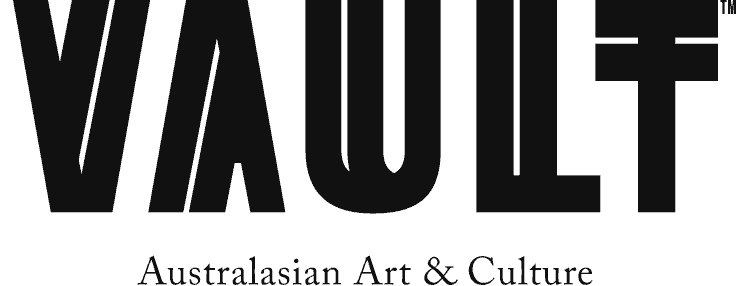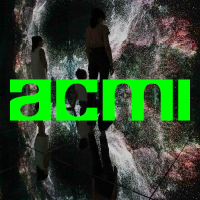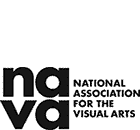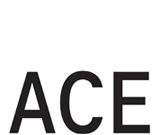EXTRA OCTOBER 2019
International News

ARTIST YUKI KIHARA AND CURATOR NATALIE KING NAMED AOTEAROA NEW ZEALAND REPRESENTATIVES FOR THE 59TH VENICE BIENNALE
The Arts Council of New Zeal and Toi Aotearoa has announced interdisciplinary artist Yuki Kihara will represent Aotearoa New Zealand at the 59th International Art Exhibition - Venice Biennale in 2021. The project will be curated by Australian Natalie King, continuing the formidable and innovative legacy of trans-Tasman collaboration in the visual arts.
Yuki Kihara is the first artist of Pacific descent to represent the nation, an historically significant inclusion for its contribution to the legacy of Aotearoa New Zealand in Venice. A native of Sāmoa, Kihara works across the visual arts, dance and curatorial projects to interrogate postcolonial histories at the intersection of race, gender, and sexual politics. Her presentation will speak to the shared histories between the Pacific and Aotearoa to examine dominant, singular historical narratives and illuminate alternative voices outside of prescribed Western identities. Most recently, Kihara’s work has appeared in The Asia Pacific Triennale (2002 and 2015); Auckland Triennale (2009); Sakahàn Quinquennial (2013); Honolulu Biennale (2017) and The Bangkok Art Biennale (2018). Her performance work and projects have also been featured in some of the world’s leading institutions including the Zendai Museum of Fine Arts, Taiwan; Royal Academy of Arts, London; Museum of Contemporary Art, Sydney; 4A Centre for Contemporary Asian Art, Sydney; Auckland Art Gallery Toi o Tāmaki and the Christchurch Art Gallery Te Puna o Waiwhetū.
As curator of the New Zealand Pavilion, Natalie King returns to the Venice Biennale with a wealth of knowledge in the realisation of projects that investigate the assumed singularity of cultural and political narratives. In 2017, she curated Tracey Moffatt: New Horizon for the Australian Pavilion at the 57th Venice Biennale, and has previously worked on projects at the National Gallery of Indonesia, Jakarta; the National Museum of Art, Osaka; Tokyo Metropolitan Museum of Photography and the Museum of Contemporary Art, Sydney, amongst others.
The collaboration between these two cultural practitioners not only continues the committed relationship between New Zealand and Australia in the realisation of contemporary art projects, it works to further instate the global South as a rigorous contributor to the international arts community.
Image credit:Yuki Kihara. Photo: Scott Lowe.
Local News

FINKELSTEIN GALLERY ADDS NINTH ARTIST JACQUI STOCKDALE TO ALL-FEMALE LINEUP
In August this year, Finkelstein Gallery opened to much applause for its commitment to representing an all-female line up of artists. This week, Director Lisa Fehily, announced the ninth artist in her suite of ten Australian and two international contemporary female artists. Melbourne-based artist Jacqui Stockdale joins emerging and established Australian artists Cigdem Aydemir, Lisa Roet, Louise Paramor, Monika Behrens, Kate Rohde, Kate Baker, Deborah Kelly and Coady, together with international artists, Kim Lieberman and Sonal Kantaria.
Jacqui Stockdale practice includes highly theatrical portrait photography, painting, drawing, collage and performance. She explores masquerade, folkloric traditions and forgotten Australian histories to interrogate the foundations of national identity. Her work has been widely exhibited in her home state of Victoria as well as throughout Australia and internationally. Her current project, The Long Shot is a provocative multi-media solo exhibition to be premiered at Linden New Art in 2020.
The approach taken under the directorship of Fehily sees Finkelstein Gallery become Australia's only operating commercial gallery to solely represent female artists. Whilst the gallery is proud to acknowledge the gender bias of represented artists as a push back against the consistent and historical disenfranchisement of female practitioners, Finkelstein Gallery first and foremost champions each artist on the basis of their rigorous and committed practice.
Image credit:Jacqui Stockdale, La Aqua, 2019, collage, 100 x 70 cm
HIGHLIGHTS

PIERRE BONNARD NGV’S WINTER BLOCKBUSTER
Summer is just around the corner, which means ironically it’s time to think about winter, traditionally a major exhibition period in Australia. Today the National Gallery of Victoria announced its winter blockbuster will be Pierre Bonnard, a world-premiere exhibition of the 20th Century artist developed in partnership with the Musée d’Orsay in Paris. Bonnard is well loved for his paintings rendered in his characteristically vibrant palette. He captured intimate portrayals of domestic scenes and rural life, and was declared by his close friend Henri Matisse ‘a great painter, for today and definitely also for the future’.
The exhibition will be unique for its immersive presentation designed by celebrated Iranian-Egyptian-French designer India Mahdavi. The NGV commissioned Mahdavi (who has appeared multiple times in Architectural Digest world’s 100 most influential architects and designers list) to bring her singular approach to colour, palette and texture, to the exhibition’s scenography. Mahdavi will envelop Pierre Bonnard’s works in an immersive environment that brings to life his iconic domestic scenes.
Alongside works from the Musée d’Orsay significant loans have been borrowed from the Tate, London; The Museum of Modern Art, New York; National Gallery of Art,Washington D.C., and Museum of Fine Arts, Boston. A key work is the NGV’s own Bonnard La Sieste 1900.
Also featured in the NGV’s Autumn Winter 2020 season is the first major Australian survey of French contemporary artist Camille Henrot, acclaimed Venice Biennale Silver Lion winner. Exploring how human beings attempt to make sense of their existence, the French-born, New York City-based artist adopts an imaginative approach to her multi-disciplinary practice. As well as, the largest ever retrospective of Melbourne based contemporary artist Destiny Deacon. With links to the K’ua K’ua and Erub/Mer people from Far North Queensland and Torres Strait, Deacon uses humour to confront our country’s difficult history. Featuring collaborations with artist Virginia Fraser, including newly commissioned works, DESTINY will feature new commissions and more than 100 photographs, videos, sculptures and installations.
Image credit: Pierre Bonnard, French, 1867-1947, La loge 1908 oil on canvas, 90.0 x 120.6 cm, Musée d’Orsay, Paris. Accepted by the State in place of payment of inheritance tax, 1989

ROBERT KLIPPEL AT TARRAWARRA MUSEUM OF ART
ASSEMBLED: The Art of Robert Klippel takes the artists sculptural methodology as its curatorial starting point to present over 100 works that exemplify Klippel’s innovative approach to scale and proportion. Curated by Kirsty Grant, the exhibition extrapolates the three key phases in Klippel’s 60-year career: his Surrealist-inspired sculptures and drawings made during the late 1940s; his ‘assemblage’ works of the 1960s and 70s; and his late timbers works that integrated brightly painted machine parts. The discarded objects that form the basis of each assembled work are rendered exquisitely with Klippel’s unique vocabulary of form and shape. It is the ‘assemblage’ for which Klippel is best known and for which this exhibition is so successful. This survey of Klippel’s career highlights recurring approaches in the practice and formation of his output, namely the ‘assemblage’ of abstract wholes from collections of discarded and dissociated parts. In TarraWarra’s forthcoming exhibition, these sculptural forms, find contemporary resonance as they pull between static and kinetic. Arguably the most playful work in the exhibition, Nos 1037-1126, Eighty-seven small polychromed tin sculptures (1995), exemplifies Klippel’s pursuit of the tension between totality and its components. In the work’s field of colourful, miniature sculptures - none measuring more than 15cm tall - the playful dance between familiar and bizarre is the late career culmination of this endeavour. Ultimately, in Klippel’s repurposing of objects he created forms that are at once tactile and impenetrable, definitive and modular, undoubtedly one of the greatest contributions to Australian modernism.
Robert Klippel at TarraWarra Museum of Art
ASSEMBLED: The Art of Robert Klippel
On show November 23 until February 16, 2020
Image credit: Robert Klippel, Nos 1037-1126 Eighty - seven small polychromed tin sculptures, 1995, polychromed tin and wire, various dimensions. Art Gallery of New South Wales, Sydney, Gift of Andrew Klippel 2002 © Andrew Klippel. Courtesy of The Robert Klippel Estate, represented by Annette Larkin Fine Art, Sydney and Galerie Gmurzynska, Zurich / Copyright Agency, 2019
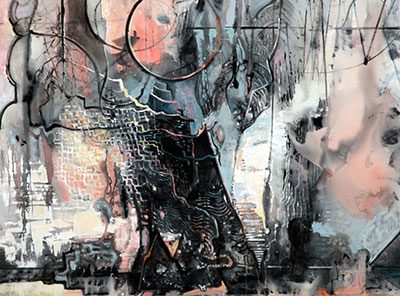
WENDY STAVRIANOS AT NICHOLAS THOMPSON
The abstraction of Wendy Stavrianos’ recent body of work results from the artist’s psychological and physical observations of the inescapable effects of contemporary climate catastrophe. The outcome is a collection of paintings, characterised by sharp contrasting pastels and deep black tones that reflect on the harsh reduction of the Australian landscape, marred by drought, dryness and heat.
Through the Window of an Inner Room is the outcome of Stavrianos’ private reverie about the deeper sentiment of objects, namely those collected in and around her central Victorian studio space. Living and working in this remote landscape, Stavrianos is a gatherer and cataloguer of objects whose beauty emerges from their tarnished environmental status. In the body of work’s transition from internal, individual space to collective viewing, Stavrianos ruminates on the known consequences of mankind’s willful misuse of the natural world.
However, these paintings cannot be viewed strictly as a defeated monologue on the effects of human environmental intervention but rather as an homage to the ‘wounded beauty’, or what remains of the natural world in a state of destruction. In intricate, dark line drawing layered on top of swathes of pinks, yellows and blue-greys, Stavrianos anchors the resilience of the Australian landscape to place and memory. It is the tension between the distinctive formal approach to colour and line in these works that expose the psychology and physicality of Stavrianos’ practice. Relying on acrylic for its qualities of immediacy and malleability, Stavrianos echoes the urgency needed from humanity to reduce climate impacts. Ultimately, the organic treatment of hues is assigned a framework in the artist’s over-drawing, exemplifying the tension between how we occupy the world and how this contributes to what remains.
Wendy Stavrianos at Nicholas Thompson Gallery
Through the Window of an Inner Room
On show until October 13
Image credit: Wendy Stavrianos, Evolving Connections, 2018-19, acrylic on canvas, 128 x 171
Current Exhibitions

RY DAVID BRADLEY AT BOWERBANK NINOW
Ry David Bradley’s Level 9 takes digitally manipulated images from the never-ending cycle of news and social media and renders them into physical, mechanically produced tapestries. In the transition from digital and intangible to wholly material, Bradley’s tapestries ruminate on a not-so-distant future where digital media may be so omnipresent that it becomes a felt part of our reality. The uncanny permanence of ephemeral imagery in Level 9’s collection of works defines a future digital space as one of innumerable potentialities.
Ry David Braldey at Bowerbank Ninow
Level 9
On show until October 19
Image credit: Ry David Bradley, >7MDFas\, 2019, acrylic tapestry, 900 mm × 640 mm
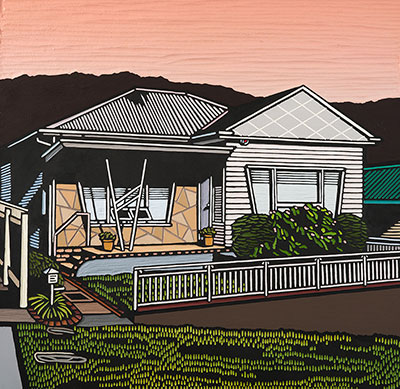
CHRISTOPHER ZANKO AT THE EGG & DART
An intimate viewing of Christopher Zanko’s work ensures it is impossible to miss the depth of carving and chiseling as a distinct act of the artist’s hand. With distance, each bold mark loses its three-dimensionality to serve the stark contrast of light and dark. It is at this duality of unique print and mass production that Zanko’s work is continually familiar and strange. In the artist’s latest exhibition, Stranger Avenue, audiences may recognise the artist’s signature, familial domestic scenes and are rewarded by the relief and texture afforded on close inspection. Ultimately, in the overt and recognisable hand-carved quality of each print, Zanko’s Stranger Avenue offers tonal contrast as a meditation on the strangeness of suburbia.
Christopher Zanko at The Egg & Dart
Stranger Avenue
On show November 6 to November 30
Image credit: Christopher Zanko, Stranger Avenue, 2019, acrylic on wood relief-carving, 60 x 60 cm
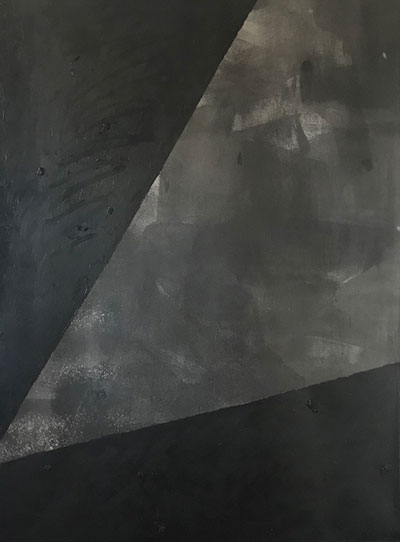
NO COLOUR AT CHAUFFEUR
CHAUFFEUR’s current exhibition No Colour: Short Meditations in Black brings together the work of Timo Kube, Ben Gavin, Matthew Allen, Alexia Destoop and Rushdi Anwar to explore the effect of black as an atmospheric and mnemonic tool. Tracing the genealogy of black and its binary opposition to white, the exhibition conjures the legacy of the great monochrome painters of the 20th century, and questions whether the absence of colour can obfuscate the effect of formalism. In the presentation of painting, installation and video, Black’s absence is experienced beyond the pictorial frame.
No Colour: Short Meditations in Black at CHAUFFEUR
On show October 17 to November 16
Image credit: Ben Gavin, Dark clouds hovering with great promise, 2018, gesso, photo emulsion and oil stick on canvas 168 x 120 cm

BALENCIAGA: SHAPING FASHION AT BENDIGO ART GALLERY
Balenciaga: Shaping Fashion travels to Bendigo Art Gallery as an exclusive Australian exhibition from the V&A, London. Continuing the gallery’s commitment to fashion and textiles, the survey exhibition brings together over 100 garments from Cristóbal Balenciaga’s early output through to the work of his contemporaries. This collection demonstrates the fashion house’s influential and innovative approach to silhouette and tailoring, which continuously challenged fashion’s assumptions of the female body. In an homage to Balenciaga’s 100-year history, the exhibition contextualises garments alongside archival sketches, patterns, photographs, fabric samples and runway footage.
Balenciaga: Shaping Fashion at Bendigo Art Gallery
On show until November 10
Image credit: X-ray showing the boning and hooped skirt. X-ray photography by Nick Veasey, 2016 © Nick Veasey. Courtesy Bendigo Art Gallery
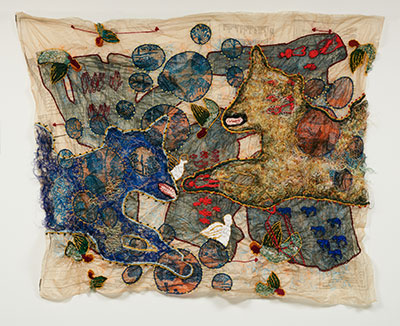
MEHWISH IQBAL AT NANDA/HOBBS
Incorporating painting, printmaking, textiles, ceramics, sculpture and installation, Mehwish Iqbal’s practice is defined by a lived, cross-cultural discourse. In her latest exhibition, The Distance Between Us, her delicate handle of fine hand embroidery on paper continues the artist’s research into hybrid identities, territorial flux and the status of the migrant diaspora in Australia. In their intricacy, Iqbal’s latest body of work speaks to the fragility and resilience of womanhood, courage, liberation and freedom.
Mehwish Iqbal at Nanda/Hobbs
The Distance Between Us
On show October 31 to November 16
Image credit: Mehwish Iqbal, Amorphous Creature, 2019, etching, collagraph, silkscreen, hand embroidery on paper, 128 x 100 cm
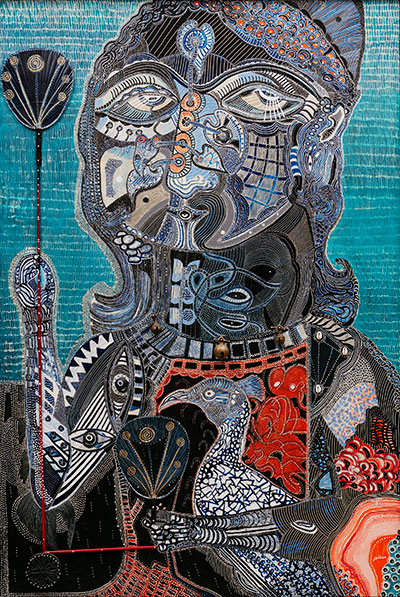
JOSHUA YELDHAM AT SCOTT LIVESEY GALLERIES
The intricately patterned and tightly covered surfaces of Joshua Yeldham’s landscapes seem at odds with the artist’s working process of mediation, heavily invested in a spiritual connection to the universe. Yeldham’s latest body of work, with its hyper decorative embodiment of his imagination, exemplifies the artist’s worldview, a commitment to an understanding of reality as a lattice of energy flows and connections. In Child of the Storm, Yeldham looks beyond the connectedness of his own self to consider the increasing difficulty of a younger generation to pursue enlightenment beyond the immediate present in the face of 21st century digital narcissism.
Joshua Yeldham at Scott Livesey Galleries
Child of the Storm
On show November 13 to December 7
Image credit: Joshua Yeldham, Bird Catcher, 2019.
